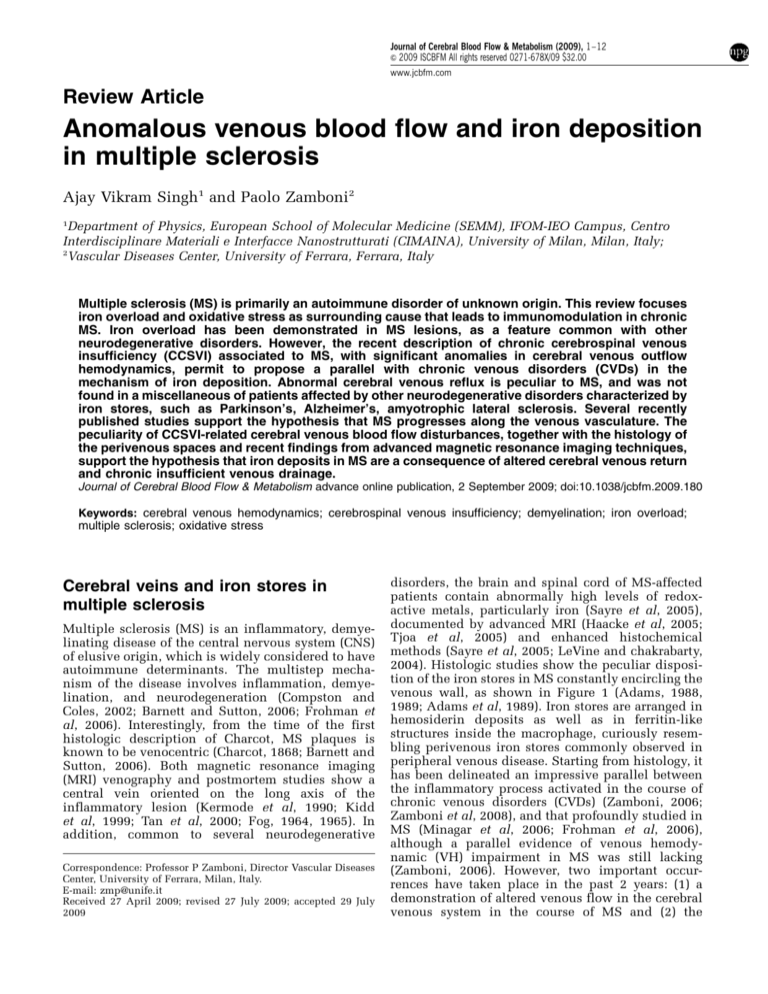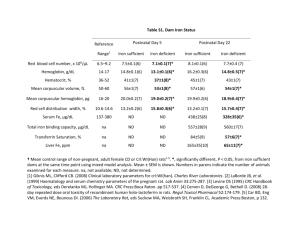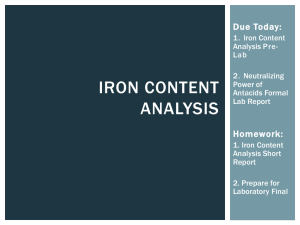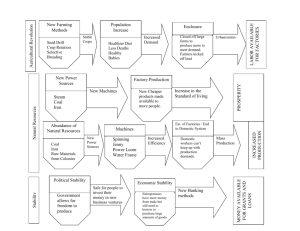
Journal of Cerebral Blood Flow & Metabolism (2009), 1–12
& 2009 ISCBFM All rights reserved 0271-678X/09 $32.00
www.jcbfm.com
Review Article
Anomalous venous blood flow and iron deposition
in multiple sclerosis
Ajay Vikram Singh1 and Paolo Zamboni2
1
Department of Physics, European School of Molecular Medicine (SEMM), IFOM-IEO Campus, Centro
Interdisciplinare Materiali e Interfacce Nanostrutturati (CIMAINA), University of Milan, Milan, Italy;
2
Vascular Diseases Center, University of Ferrara, Ferrara, Italy
Multiple sclerosis (MS) is primarily an autoimmune disorder of unknown origin. This review focuses
iron overload and oxidative stress as surrounding cause that leads to immunomodulation in chronic
MS. Iron overload has been demonstrated in MS lesions, as a feature common with other
neurodegenerative disorders. However, the recent description of chronic cerebrospinal venous
insufficiency (CCSVI) associated to MS, with significant anomalies in cerebral venous outflow
hemodynamics, permit to propose a parallel with chronic venous disorders (CVDs) in the
mechanism of iron deposition. Abnormal cerebral venous reflux is peculiar to MS, and was not
found in a miscellaneous of patients affected by other neurodegenerative disorders characterized by
iron stores, such as Parkinson’s, Alzheimer’s, amyotrophic lateral sclerosis. Several recently
published studies support the hypothesis that MS progresses along the venous vasculature. The
peculiarity of CCSVI-related cerebral venous blood flow disturbances, together with the histology of
the perivenous spaces and recent findings from advanced magnetic resonance imaging techniques,
support the hypothesis that iron deposits in MS are a consequence of altered cerebral venous return
and chronic insufficient venous drainage.
Journal of Cerebral Blood Flow & Metabolism advance online publication, 2 September 2009; doi:10.1038/jcbfm.2009.180
Keywords: cerebral venous hemodynamics; cerebrospinal venous insufficiency; demyelination; iron overload;
multiple sclerosis; oxidative stress
Cerebral veins and iron stores in
multiple sclerosis
Multiple sclerosis (MS) is an inflammatory, demyelinating disease of the central nervous system (CNS)
of elusive origin, which is widely considered to have
autoimmune determinants. The multistep mechanism of the disease involves inflammation, demyelination, and neurodegeneration (Compston and
Coles, 2002; Barnett and Sutton, 2006; Frohman et
al, 2006). Interestingly, from the time of the first
histologic description of Charcot, MS plaques is
known to be venocentric (Charcot, 1868; Barnett and
Sutton, 2006). Both magnetic resonance imaging
(MRI) venography and postmortem studies show a
central vein oriented on the long axis of the
inflammatory lesion (Kermode et al, 1990; Kidd
et al, 1999; Tan et al, 2000; Fog, 1964, 1965). In
addition, common to several neurodegenerative
Correspondence: Professor P Zamboni, Director Vascular Diseases
Center, University of Ferrara, Milan, Italy.
E-mail: zmp@unife.it
Received 27 April 2009; revised 27 July 2009; accepted 29 July
2009
disorders, the brain and spinal cord of MS-affected
patients contain abnormally high levels of redoxactive metals, particularly iron (Sayre et al, 2005),
documented by advanced MRI (Haacke et al, 2005;
Tjoa et al, 2005) and enhanced histochemical
methods (Sayre et al, 2005; LeVine and chakrabarty,
2004). Histologic studies show the peculiar disposition of the iron stores in MS constantly encircling the
venous wall, as shown in Figure 1 (Adams, 1988,
1989; Adams et al, 1989). Iron stores are arranged in
hemosiderin deposits as well as in ferritin-like
structures inside the macrophage, curiously resembling perivenous iron stores commonly observed in
peripheral venous disease. Starting from histology, it
has been delineated an impressive parallel between
the inflammatory process activated in the course of
chronic venous disorders (CVDs) (Zamboni, 2006;
Zamboni et al, 2008), and that profoundly studied in
MS (Minagar et al, 2006; Frohman et al, 2006),
although a parallel evidence of venous hemodynamic (VH) impairment in MS was still lacking
(Zamboni, 2006). However, two important occurrences have taken place in the past 2 years: (1) a
demonstration of altered venous flow in the cerebral
venous system in the course of MS and (2) the
Venous hemodynamics and iron stores in MS
AV Singh and P Zamboni
2
Figure 1 Histology of a brain MS plaque (hematoxylin-eosin
50). The figure depicts a streak of blood (arrows) encircling
the wall of a vein (V) at the center of an MS brain plaque. Heme
iron triggers macrophages infiltration, demonstrated by the
presence of iron-laden phagocyte (M).
development of advanced MRI techniques that have
brought about an extraordinary improvement in the
capacity to assess iron stores and cerebral veins.
This review delineates the role of iron in the
complex pathogenesis of MS and corroborates the
hypothesis that iron overload in MS is secondary to
disturbed venous flow in the cerebral veins.
Metallobiology of central nervous
system iron and putative role in
pathogenesis of multiple sclerosis
Physiologic Role and Regulation of Iron in the Central
Nervous System
Iron is important for CNS physiology as it acts as
cofactor for enzyme cascade of neural metabolism
and ATP production. Further, it is required by all
living cells, whether neuronal or other cells, taking
part in tissue formation, angiogenesis, oxygen transport, electron transfer, and neurotransmitter synthesis (Chua et al, 2007). Most importantly, iron is
instrumental in myelination and oligodendrocyte
development as it is required by most of the growth
factors involved in these processes. This fact is
supported by such evidence as low iron content in
hypomyelinated brains and deeply stained ironenriched oligodendrocytes in the white matter of
normal and diseased brains (Todrich et al, 2009).
Moreover, neuronal cells from the brain and spinal
Journal of Cerebral Blood Flow & Metabolism (2009), 1–12
cord use iron for routine functions and maintenance
of cellular homeostasis that can be reflected by the
presence of abundant transferrin receptors on brain
capillary endothelial cells (Sipe et al, 2002; Ke and
Qian, 2003).
Transferrin is a glycoprotein that is responsible for
iron homeostasis in vivo; it maintains the iron pool
in the systemic circulation by binding with iron
tightly but reversibly. Oxygen is the elixir of life, and
glial cells in the brain require more oxygen and
glucose consumption to generate a continuous ATP
pool in vivo than do other organs. A continuous ATP
pool is essential to normal functioning of the brain,
which is one of busiest organs and keeps all other
organs active and under control. Neurons are highly
polarized, and proteins of neuronal homeostasis and
CNS physiology are synthesized in cell bodies and
then transported to functional sites at synapses. In
cooperation with iron regulatory proteins, ferritin,
and ferroportin, transferrin maintains the iron requirement under control across neuron transport in
the CNS by regulating iron absorption, transport,
storage, and utilization by brain cells (Rouault, 2001;
Yang et al, 1984; Chua et al, 2007).
Role of Iron in Aging
With advancing age, iron accumulates in the brain
and has been associated with senile dementia, many
cognitive dysfunctions, and neurodegenerative disorders (Altamura and Muckenthaler, 2009). Although
it is unclear how iron accumulates as age progresses,
in a recent report Jeong and coworkers showed that
multiple mechanisms may lead to iron accumulation
in neurons and glia. These mechanisms include
dysregulation of the proteins involved in iron influx
and sensing of intracellular iron; iron accumulation
in ventral motor neurons secondary to blockage of
anterograde axonal transport; and increased mitochondrial iron load (Jeong et al, 2009). This finding
may pave the way to a better understanding of iron
accumulation in the aged brain.
Moreover, anatomic and metabolic features of the
aged brain make it more susceptible to iron accumulation and subsequent reactive oxygen speciesmediated toxicity. Glia, the principal cells in the
brain that provide metabolic and anatomic support
to neurons and other CNS cells, have a high lipid
content and a greater requirement for glucose and
oxygen for the ATP pool in the brain (Giaume et al,
2007). A higher lipid and oxygen content, in the
presence of iron in glial cells and associated neurons,
creates an environment of peroxidation of lipids,
proteins and DNA in the aged brain through the
Fenton reaction, described in later section (Zaleska
and Floyd, 1985; Van Rensburg et al, 2004). In
addition, low antioxidant activity and low regenerative capacity of brain cells after injury, render the
aged brain weak in combating iron-mediated toxicity
in older people (Van Rensburg et al, 2004).
Venous hemodynamics and iron stores in MS
AV Singh and P Zamboni
Role of Iron in Neurodegenerative Disorders
The role of metallobiology in neurodegenerative
disorders has long been implicated, with particular attention given to iron as it is one of the most
important redox metals, which have been largely
linked to senile toxicity and neurodegenerative
disorders such as Alzheimer’s and Parkinson’s
diseases and aging patients (Bush, 2000; Sullivan,
2004; Altamura and Muckenthaler, 2009; Stankiewicz et al, 2007; Stankiewicz and Brass, 2009). The
redox switching capability of iron from ferrous to
ferric state, and vice versa, makes it one of the most
dangerous catalytic elements responsible for the
neurodegenerative process (Levenson and Tassabehji, 2004). The role of iron in the neurodegenerative
process can be best described in three distinct
phases: accumulation, invasion, and catalytic activity. Iron accumulation in the brain follows a nonuniform distribution, both regionally and cellularly, that
reflects the differential requirements of iron and its
regulation in proportion to regional brain activity.
Regions of the brain that are associated with motor
functions (extrapyramidal regions) tend to have more
iron than nonmotor-related regions (Koeppen, 1995).
Similarly, oligodendrocytes, microglia, and neurons
undergo deep immunostaining in the aged brains of
patients with Alzheimer’s and Parkinson’s diseases,
indicating a higher than usual cellular iron content
(Levenson and Tassabehji, 2004; Zecca et al, 2004).
Particularly in microglia, a higher iron content
clearly depicts the role of iron in activating the
immunoinflammatory cascade in neurodegenerative
disorders (Zecca et al, 2004). During invasion and
increased activity, stored iron generates free radicals
and reactive oxygen species in the aged brain, as
evidenced by higher heme oxygenase-I, which contributes to increased susceptibility to oxidative stress
in older people (Hirose et al, 2003). Biochemical
events surrounding iron-mediated catalytic events,
which give rise to oxidative stress and free radical
generation can be given as
Fe3 + + O2 -Fe2 + + O2 (Step I)
Fe2 + + H2O2-Fe3 + + OH + OH (Step II) *
Combining Step I & II
O2 + H2O2- OH + HO + O2
*Known as Fenton reaction (Hunt, 2009).
K
K
K
K
Iron Overload in Multiple Sclerosis
Although investigations into the role of iron in MS
are still few, many high-resolution MR techniques
have shown stored iron regions inside the brain and
spinal cord. Moreover, in experimental autoimmune
encephalomyelitis (EAE), an animal model of MS,
dietary modifications have revealed an incidence of
EAE in B70% of mice with a normal iron level or
iron overload, but 0% in iron-deficient mice. This is
clear evidence that iron deficiency protects against
the progress of MS in mice with induced EAE, with
3
obvious clinical implications (Grant et al, 2003). The
authors speculated that the failure of iron-deficient
mice to develop EAE is impressive, but controversy
remains as iron deficiency may lead to much more
serious health hazards. However, they conclude that
any of the pharmaceutical approaches to inhibiting
EAE are less effective than iron deficiency. Another
study that correlated iron overload and MS revealed
variations in the level of protein expression involved
in iron homeostasis. Sfagos et al investigated the
serum concentration of soluble transferrin receptor
in a group of MS patients. The levels were found to
be significantly higher in patients with active MS, in
both progressive and relapsing-remitting clinical
forms, than in controls. Serum ferritin levels were
also significantly elevated in patients affected by the
active and progressive form of MS. These findings
reinforce the above argument, which proposes local
iron overload as a pivotal signal of the inflammatory
chain in MS (Sfagos et al, 2005). In addition, higher
levels of soluble transferrin receptors and increased
transferrin receptor in the serum of nonanemic MS
patients with active disease, which reflect increased
iron turnover, may indicate active inflammation with
ongoing oxidative damage that is not detectable by
patient history or examination (Abo-Krysha and
Rashed, 2008). In a recent review, Trap and Stys
hypothesized in MS that imbalance in the increased
energy demand of impulse conduction along excitable demyelinated axons, together with reduced
axonal ATP production, induce a hypoxia-like
state in chronically demyelinated axons, caused by
mitochondria and ion-gated channel dysfunction
(Trapp and Stys, 2009).
Biological Links of Iron Overload to Autoimmune
Inflammation in Multiple Sclerosis
Multiple sclerosis is believed to be primarily an
autoimmune disorder with an initial trigger suspected among environmental factors (including viral
infection, bacterial lipopolysaccharides, and superantigens) impacting a genetic predisposition. The
initial trigger facilitates the movement of autoreactive T-helper (Th) cells and demyelinating antibodies
from the systemic circulation into the CNS through
disruption of the blood–brain barrier (Noseworthy
et al, 2000).
Autoimmune cells mainly destroy oligodendrocytes, the cells responsible for creating and maintaining a fatty layer known as the myelin sheath,
which helps the neurons to carry action potentials
across axonal pole. In MS, this myelin sheath
becomes thin or completely disappears. Most importantly, due to the repeated attacks of autoimmune
cells, the remyelination capacity of the insulating
sheath is lost, leading to scar-like plaques or lesions
situated around the damaged axons (Chari, 2007).
However, in such a scenario, iron overload and
oxidative stress may be the underlying cause that
Journal of Cerebral Blood Flow & Metabolism (2009) 00, 1–12
Venous hemodynamics and iron stores in MS
AV Singh and P Zamboni
4
Figure 2 Autoimmunitary attack to myelin. The role of major cells from immune cascade those attack and damage to the myelin
sheath under autoimmune modulation across cerebrospinal region, triggered by iron overload and oxidative stress (IL, interleukin; Th,
T-helper cells; MMP, matrix metallo proteinase; MHC, major histocompatibility complex; TNF-a, tumor necrosis factor-a; IFN-g,
interferon-g).
leads to immunomodulation in chronic MS. Perivascular extravasation of erythrocytes has been demonstrated in plaques of patients with a recent relapse
of MS (Adams, 1988). Biologically, the erythrocyte
is degraded in the tissues by heme oxygenase.
This enzyme, together with carbon monoxide, which
is one of the products of the reaction, is a major
regulator of the T-lymphocytes CD4 + (Brusko et al,
2005). In addition, the iron deposits represent a
powerful chemotactic stimulus that attracts macrophages. This is confirmed by the presence of ironladen macrophages in the MS plaques, as shown in
Figure 1 (Adams, 1988, 1989; Zamboni, 2006;
Zamboni et al, 2008).
Furthermore, it has been observed that the cells
involved in iron overload having the greatest effect
on immunity are the macrophages, and that there is
a close relationship between iron and the major cells
of adaptive immunity, the T-lymphocytes, as they
have a major function in recycling the iron from
hemoglobin (Porto et al, 2007).
Figure 2 describes the role of major cells from
immune cascade those attack and damage to the
myelin sheath across cerebrospinal region triggered
by iron overload and oxidative stress during the
course of autoimmune inflammation.
Moreover, INF-g is produced by T-lymphocytes
and seems to be the main mediator of neurodegeneration (Brusko et al, 2005; Frohman et al, 2006).
However, INF-g is simultaneously responsible for
T-lymphocyte apoptosis. Therefore, under normal
conditions, a positive feedback loop resulting in a
high local concentration of INF-g cannot develop.
Journal of Cerebral Blood Flow & Metabolism (2009), 1–12
Several studies have shown the role of iron in
T-lymphocyte regulation, and iron induces their
refractoriness to INF-g/STAT1 signaling. Thus, iron
can determine a longer survival of T-lymphocytes
exposed to INF-g, increasing the potentiality of
INF-g-mediated neuronal damage (Regis et al, 2005).
Physiology of cerebral venous return
and venous blood flow alterations
discovered in multiple sclerosis
The blood leaves the brain by using the back
propulsion of the residual arterial pressure (vis a
tergo), complemented by antegrade postural and
respiratory mechanisms (vis a fronte) as shown in
Figure 3 (Ursino and Lodi, 1997; Schaller, 2004;
Menegatti and Zamboni, 2008).
The latter consists of increased venous outflow
during inspiration, thanks to increased thoracic
negative pressure, which improves the aspiration of
blood toward the right atrium. Moreover, the supine
posture favors cerebral venous outflow through
the internal jugular veins (IJVs); on the contrary, in
the upright position, blood is redirected through the
vertebral veins and the azygous vein (AZ), which
become the predominant pathways in that position
(Ursino and Lodi, 1997; Schaller, 2004; Menegatti
and Zamboni, 2008).
It has been recently shown that MS is significantly associated with a condition defined as
chronic cerebrospinal venous insufficiency (CCSVI)
Venous hemodynamics and iron stores in MS
AV Singh and P Zamboni
5
Figure 3 Physiology of cerebral venous return. The blood leaves
the brain by using the back propulsion of the residual arterial
pressure (vis a tergo), much more important in the cerebral
veins, complemented by antegrade postural and respiratory
mechanisms (vis a fronte), which has a major function in the
dural sinuses and in the jugular and azygous vein (IJV-AZ). In
fact, the blood flow velocity is higher close to the chest, due to
the negative thoracic pressure gradient, increased by inspiration.
According to the Bernoulli law, by increasing the blood flow
velocity there is a corresponding reduction of the lateral pressure
resulting in a natural aspiration of the deep cerebral veins (DCVs)
into the sinuses, and finally into the main outflow extracranial
pathways, IJV-AZ.
(Zamboni et al, 2009a, b, c). The CCSVI is characterized by multiple stenoses of the principal pathways
of extracranial venous drainage, the IJVs and the
AZ, with opening of collaterals, clearly demonstrated
by means of selective venography, as depicted in
Figure 4. The presence of stenotic lesions that cannot
be crossed by postural and respiratory mechanisms
explains the higher rate of reverse flow recorded in
the main extracranial venous outflow route.
In MS patients, venous stenoses in the main
cerebrospinal outflow pathways were never found
to be isolated. Rather, they were combined in the
IJVs, AZ, and lumbar systems, defining four main
patterns of distribution (Zamboni et al, 2009b):
(i) Type A pattern (30%) is characterized by a
stenoobstruction of the proximal AZ, associated
with a closed stenosis of one of the two IJVs,
with a compensatory controlateral IJV that
appears with an ample cross-sectional area;
(ii) Type B pattern (38%) is characterized by
significant stenoses of both IJVs and the
proximal AZ;
(iii) Type C pattern (14%) is characterized by
bilateral stenosis in both IJVs, with a normal
AZ system;
(iv) Type D pattern (18%) is characterized by
the multilevel involvement of the AZ and
lumbar systems. Association with the IJVs was
observed in approximately 50% of cases,
Figure 4 Extracranial venous stenosis associated to MS (CCSVI).
Selective venography in the course of CCSVI associated to MS.
Left: proximal stenosis of the left IJV (arrow) with agenesia more
distally (A). Intra–extra cranial collateral circle (CC1) represented
by condylar veins shunts the double block, whereas the agenesia
is bypassed by an extracranial collateral (CC). Right: Twisting
of the descending segment of the AZ just below the arch
communicating with the superior vena cava (SVC).
causing an additional obstruction in these
patients. Type D is significantly associated with
the PP course of MS, characterized by a plaque
topography in the spinal cord.
The CCSVI brings about an overturning of the
above-described postural and respiratory mechanisms, rendering abnormal the physiology of cerebral
venous return (Zamboni et al, 2007, 2009b, c). Combined transcranial and extracranial echo-colorDoppler allows for measurement of VH parameters
indicative of CCSVI (Zamboni et al, 2009c). The
CCSVI diagnosis needs to fulfill at least 2 out of 5 VH
parameters (Zamboni et al, 2009b, c). The detection
of Z2 parameters in the same subject was never
observed in controls (Zamboni et al, 2009c), but
perfectly overlapped with the diagnosis of clinically
definite MS (sensitivity 100%, specificity 100%,
positive predictive value 100%, and negative predictive value 100%). Despite the strong association
found between CCSVI and MS, it has not yet been
clarified whether such extracranial venous obstructions can be considered a cause or an effect of MS.
Role of Venous Collateral Circulation and the Concept
of Vicarious Venous Shunt
Significant obstacles to the main venous outflow
collectors, with overload of collaterals and associated refluxes, have been described at the level of
the iliac veins in obstructive CVD, and also in the
inferior vena cava in primary Budd-Chiari syndrome
(Bergan et al, 2006; Raju et al, 2006; Lee et al, 2006).
Journal of Cerebral Blood Flow & Metabolism (2009) 00, 1–12
Venous hemodynamics and iron stores in MS
AV Singh and P Zamboni
6
Figure 5 Main collateral circles activated in the course of CCSVI-MS. Substitute circles frequently activated in the course of chronic
obstruction of the IJVs. (A) The superior and the middle thyroid veins drain into the IJVs, whereas the inferior thyroid vein drains into the
brachiocephalic trunk, permitting to bypass the obstacle. (B) The pterygoid plexus (PTER. PLEX.) is one of the preferential intra–extra
cranial venous anastomoses. (C) The three condylar veins, connected, respectively, with the thyroid veins and with the vertebral plexus.
Similarly, in CCSVI, the main extracranial cerebrospinal veins are blocked, with opening of substitute
circles. When venous flow is deviated into collaterals to bypass an obstacle, there exists an anatomic
bypass called a vicarious shunt (Franceschi, 2009;
Zamboni et al, 2009a).
This type of shunt is desirable because it bypasses
blocked veins and thereby reduces resistance to
drainage. Blood flows regularly in the substitute
circle under the effects of distal cardiac residual
pressure and proximal thoracoabdominal aspiration.
Opening of extraintracranial draining anastomosis is
depicted by vascular imaging in CCSVI (Zamboni et
al, 2009b) as shown in Figure 4. However, the time of
venous outflow is longer than normal, leading to
insufficient venous drainage, as confirmed by the
mean transit time measured in MR perfusion study,
even in normal-appearing white matter (Law et al,
2004). The main collateral pathways activated in
the course of CCSVI are depicted in Figure 5: the
condylar venous system, the pterygoid plexus, the
thyroid veins. Additionally, the suboccipital cavernous sinus and the hemiazygous-lumbar venous
anastomosis with the left renal vein may also become
prominent substitute circles. Collateral circulation
prevents brain edema and intracranial hypertension
(Schaller, 2004; Zamboni et al, 2009a), and ensures a
correct but slower, and thus insufficient, venous
drainage.
Peculiarity of Anomalous Cerebral Venous Blood Flow
in Multiple Sclerosis and Possible Contribution to the
Inflammatory Chain
Blocked extracranial venous blood outflow causes a
high rate of cerebral venous reflux in MS patients, as
Journal of Cerebral Blood Flow & Metabolism (2009), 1–12
shown in earlier studies (Zamboni et al, 2007,
2009a, b, c). This detected reflux, propagated from
the chest and neck veins into the parenchymal veins
of the brain, may have an important function in
explaining the mechanism of iron overload in MS.
By contrast, venous reflux and oscillatory flow in the
periventricular veins have not been found in patients
affected by other neurodegenerative diseases with
increased iron stores, such as Alzheimer’s and
Parkinson’s diseases, and amyotrophic lateral sclerosis, as shown in Table 1. The VH parameters detected
in these and other miscellaneous neurologic disorders closely resembled those found in healthy
controls and healthy elderly subjects (Zamboni et al,
2009b, c). More specifically, the rate of venous
reflux flow detected in the main extracranial cervical
veins of MS patients was 70% with respect to 0%
detected in the three control populations. It has been
shown that extracranial reflux was also transmitted
up to the deep cerebral venous system in 50% of
MS cases, as shown in Figure 6, but was detected
neither in healthy controls nor in patients with
other neurologic diseases (Table 1) (Zamboni et al,
2009b, c).
Altered hemodynamics have been documented by
transcranial echo-color-Doppler in veins anatomically related to MS lesions. These alterations cause a
high rate of reverse flow with a chaotic displacement
of blood at the activation of the thoracic pump,
a phenomenon never observed in controls (Zamboni
et al, 2007, 2009b, c). By contrast, cerebral VHs in
healthy subjects are characterized by a laminar,
monodirectional flow with low velocity (Valdueza
et al, 1996; Stolz et al, 1999; Baumgartner et al, 1997;
Zamboni et al, 2007).
It has been established that steady laminar shear
stress promotes a release of factors from endothelial
Venous hemodynamics and iron stores in MS
AV Singh and P Zamboni
7
Table 1 Cerebral venous Doppler haemodynamic parameters of CCSVI
Parameters
1. Reflux constantly present in IJVs and/or
VVs with the head at 01 and +901
2. Reflux in the deep cerebral veins
3. High resolution B-mode evidence of
proximal IJV stenoses
4. Flow not Doppler detectable in the IJVs
and/or VVs
5. Negative DCSA in the IJV
Conclusive analysis Z2 positive parameters
Multiple Neurodegenerative
Other Neuro
sclerosis
immune diseaseb
diseasea
(%)
(%)
(%)
Neuro degenerative
P (two-sided
vascular diseasec Fisher exact test)
(%)
70
5d
0
0
< 0.0001
50
28
0
5
0
0
0
0
< 0.0001
< 0.0001
32
0
14
0
< 0.0001
58
100
32
0
14
0
32
0
< 0.0001
< 0.0001
a
Neurodegenerative disease: Parkinson’, amiotrophic lateral sclerosis, Alzheimer’.
Neuroimmune disease: myastenia gravis, multifocal motor neuropathy.
c
Cerebrovascular disease: stroke vascular dementia.
d
This parameter has been found only in patients with Amiotrophic lateral sclerosis and severe impairment of the muscular thoracic pump.
b
Figure 6 Reflux flow mapping in the cerebral venous system found in CCSVI-MS. Map of venous reflux flow in MS and in healthy
controls. In the diagram, areas investigated by means of high resolutions vascular ultrasounds. Legends: Yellow arrows normal flow
direction, red arrows reflux flow; SSS (superior saggital sinus), CS (confluence sinus), TS (transverse sinus), SS (straight sinus), DCVs
(deep cerebral veins including Galen vein (GV), internal cerebral veins (ICVs), Rosenthal vein (RV)), IPS (inferior petrosus sinus), IJVs
(internal jugular veins). A Area: reflux rate in the extracranial main pathways, IJVs and azygous vein; B Area: reflux rate in the TS; C
Area: reflux rate in the DCVs; D Area: reflux rate in the veins connecting the subcortical gray matter with the DCVs. The color
reproduction of this figure is available on the html full text version of the manuscript.
cells that inhibit coagulation and migration of
leukocytes, while simultaneously promoting normal
function in endothelial cells (Bergan et al, 2006;
Sorescu et al, 2004). Conversely, where there occurs
a disturbance or, especially, a reversal of flow direction, one or both factors may promote an inflammatory reaction, and particularly the expression of
surface adhesion molecules (Bergan et al, 2006;
Sorescu et al, 2004). Therefore, the oscillatory flow
assessed in the cerebral venous system can be considered a proinflammatory stimulus, potentially contributing to MS multifactorial etiopathogenesis (Zamboni
et al, 2007). The expression of adhesion molecules on
the endothelial part of the blood/brain barrier facilitates
macrophage and T-cell adhesion, migration, and infiltration, and is considered to be a crucial vascular factor
in the development of MS (Frohman et al, 2006;
Minagar et al, 2006; Geppert and Losy, 1999).
Journal of Cerebral Blood Flow & Metabolism (2009) 00, 1–12
Venous hemodynamics and iron stores in MS
AV Singh and P Zamboni
8
Table 2 Molecular and physiological parallelism in CVD and CCSVI-MS
Clinical findings
CVD
References
CCSVI-MS
Altered venous outflow hemodynamics
+++
Bergan et al (2006)
Perivenous inflammation
+++
Bergan et al (2006); Zamboni et al
(2003, 2005, 2006)
Metal molecular physiology of nephron
++
Zamboni et al (2005)
NO molecular biology
++
Ailish et al (2008)
++
+++
++
+
References
Zamboni et al (2007, 2009b, c)
Fog (1964); Adams (1988);
Kermode et al (1990); Frohmann
(2006)
Exley et al (2006)
Hooper et al (1997)
T cell migration-infiltration
+
Wilkinson et al (1993)
+++
Martino et al (2002); Frohmann
et al (2006); Minagar et al (2006)
Cytokine production (TNF-a, IFN-g, IL-2)
+
Raffetto, (2009)
+++
Lin et al (1997); Frohmann
(2006)
Macrophage migration-infiltration
++
Zamboni et al (2005);
Wilkinson et al (1993)
+++
Adams (1988) Martino et al
(2002); Kuenz et al (2005)
Iron molecular pathology
+++
Zamboni et al (2008)
+++
Drayer et al (1987)
Ferritin/hemosiderin deposits
++
Zamboni et al (2003, 2005)
MMP/TIMP molecular pathology
+++
Zamboni et al (2005); Herouy et al
(2001); Wenk et al (2001)
+++
Fainardi et al (2006); Lillian et al
(2009)
Cell adhesion molecules (CAMs)
activation
+++
Wilkinson et al (1993)
+++
Martino et al (2002); Kuenz et al
(2005)
Iron laden-macrophage
++
Zamboni (2006); Takase et al
(2004)
++
Adams (1989); Adams et al
(1989)
Altered pericapillary Fibrin physiology
+++
Brown (2005); Browse and
Burnand (1982)
++
Adams (1989); Adams et al
(1989); Campos-de-Magalhães
et al (2009)
Erythrocyte extravasation
+++
Zamboni et al (2005); Bergan et al
(2006)
++
Putnam (1937); Allen (1981);
Adams (1989); Adams et al
(1989)
++
Adams (1988, 1989);
Note: + indicates low level correlation and parallelism with few evidences available in literature search.
++ indicates moderate level correlation and parallelism with sufficient evidences available in literature search.
+++ indicates strong correlation and parallelism with major evidences available in literature search.
Molecular and Pathophysiologic Parallelism between
Chronic Venous Disorder and Multiple Sclerosis:
The Hypothetical Mechanism of Iron Deposition in
Multiple Sclerosis
Chronic venous diseases and CCSVI associated with
MS have many similarities in the molecular and
physiologic mechanisms involved in iron-mediated
disease development. The basic molecular mechanisms involved in iron overload and oxidative stress,
leading to inflammation in CCSVI and CVD, follow
similar routes at the molecular level (Simka and
Rybak, 2008). In CVD, the chain is triggered by
altered VHs with consequent disturbed microcirculation, bringing about erythrocyte extravasation as a
primary source of iron stores (Bergan et al, 2006;
Zamboni et al, 2006, 2008). We hypothesize that the
same mechanism could also be responsible for iron
deposition in CCSVI associated with MS (Zamboni,
2006; Zamboni et al, 2008). Histology confirms
erythrocyte extravasation in brain plaques of MS
just at the perivenular level (Adams, 1988, 1989;
Zamboni, 2006). Figure 1 depicts a streak of blood
Journal of Cerebral Blood Flow & Metabolism (2009), 1–12
encircling the venous wall in an MS plaque. The
mechanisms involved in MS and CVD have many
common features that exhibit intriguing similarities
in the iron-mediated pathophysiology of the disease
mechanisms (Zamboni, 2006). The recent description
of altered VHs, together with immune cascade
infiltration, systemic cellular pool extravasations,
altered physiology of nephron metallobiology and
classical theories explaining fibrin cuff and T-cell
iron-laden macrophages indicate many similarities
between MS and CVD, and are summarized in Table 2.
In CVD, it is well established that the same altered
VH conditions negatively affect tissue drainage, with
development of chronic inflammation, iron deposition, and various degrees of tissue injury. In CVD at
the microcirculatory level, erythrocyte sludge facilitates the transmigration of these cells and subsequent extravascular hemolysis, leading to increased
pericapillary iron deposition (Bergan et al, 2006;
Zamboni et al, 2005; Zamboni, 2006). Interestingly,
several peculiar histologic aspects of insufficient
venous drainage, that is, erythrocyte extravasation,
iron-laden macrophages with extracellular hemosi-
Venous hemodynamics and iron stores in MS
AV Singh and P Zamboni
9
derin deposits, and pericapillary fibrin cuffs, have
also been demonstrated in CCSVI associated with
MS (Adams, 1988, 1989; Zamboni et al, 2008).
Perspectives in advanced magnetic
resonance imaging techniques
Recent advances in imaging techniques for iron
detection may contribute substantially to understanding the role of iron in MS pathology and to
developing iron-based biomarkers for disease progression (Ceccarelli et al, 2009), which might correlate better to the CCSVI condition. Recently
published studies support the hypothesis that MS
progresses along the venous vasculature, exactly
as the reflux pathways described above (Hammond
et al, 2008; Haacke et al, 2009a, b). However, at
present, despite the intriguing parallel in the mechanisms of iron deposition between CCSVI and
CVD, we cannot definitely prove this hypothesis.
Advanced MRI techniques will be probably needed
for deeper insights. Absolutely promising from this
point of view is the susceptibility weighted neuroimaging technique (SWI), which uses the magnetic
susceptibility differences of tissues to generate a
unique contrast (Haacke et al, 2005), technically
different from that of spin density, T1-weighted, T2weighted, which can detect iron deposits (Tjoia et al,
2005; Zivadinov and Bakshi, 2004; Zivadinov et al,
2008). Additionally, SWI is capable of extracting and
impressively depicting the morphology of cerebral
veins, possibly measuring the cerebral blood volume
(Haacke et al, 2009a, b). In perspective, the ability to
unravel cerebral blood volume changes in MS and
oxygen saturation changes is another key element
that may be possible combining SWI with single
vessel imaging (Haacke et al, 1997; Trapp and Stys,
2009) or susceptibility mapping (Haacke et al, 2005),
all of which may help paint a more consistent picture
of what is happening on the venous side in the
course of CCSVI.
Moreover, recently researchers have shown that
ultra-small superparamagnetic particles of iron oxide
(USPIO) can visualize cellular infiltration and pluriformity of inflammation in MS more accurately than
do traditional techniques.
On systemic application, USPIO is preferentially
phagocytosed by monocytes before clearance within
the reticuloendothelial system of the liver, spleen,
and lymph nodes. On acute migration into the
diseased nervous system, these iron oxide-laden
macrophages become visible on MRI by the superparamagnetic effects of iron oxide resulting in a
signal loss on T2-weighted and/or bright contrast on
T1-weighted MRI. Iron oxide-contrast-enhanced MRI
allowed in vivo visualization of cellular inflammation in patients with MS (Stoll and Bendszus, 2009).
Importantly, cellular MRI provides additional information to gadolinium-DTPA-enhanced MRI as cel-
lular infiltration and breakdown of the blood–brain
barrier are not closely linked (Dousset et al, 2006).
In addition, USPIO-enhanced MRI seems to be a
new marker for diffuse inflammation in MS normalappearing white matter (Vellinga et al, 2009). Interestingly, three patterns of USPIO-enhancement have
been observed, contrary to routine Gd-DTPA, showing that sensitivity and specificity of MRI in MS can
be improved using USPIO. These patterns are (1)
focal enhancement, (2) ring-like enhancement, and
(3) return to isointensity of an earlier hypointense
lesion (Vellinga et al, 2008). Both USPIO and SWI
detect ring-like enhancement in MS lesions. Perhaps
these two approaches could be combined, thereby
contributing to a better understanding of the anatomical and functional relationships between cerebral
veins and plaques in MS.
Finally, the latest and most promising technique is
4D MRI angiography, which may make it possible
to measure blood flow in cerebral veins, helping to
confirm and/or correlate the transcranial Doppler
hemodynamic parameters described above (Eddleman et al, 2009; Spuentrup et al, 2009; Willinek et al,
2008).
Acknowledgements
Hilarescere Foundation supports a research program
on Venous Function and Multiple Sclerosis at the
Vascular Diseases Center, University of Ferrara, Italy.
AVS thanks to European School of Molecular
Medicine (SEMM) for supporting his own research
grant. We thank Uttara Bayani, MS, for invaluable
assistance at various stages of manuscript preparation. We thank Mrs Patricia Jo Ennis for her revision
of the English language.
Conflict of interest
The authors declare no conflict of interest.
References
Abo-Krysha N, Rashed L (2008) The role of iron dysregulation in the pathogenesis of multiple sclerosis: an
Egyptian study. Mult Scler 14:602
Adams CW (1988) Perivascular iron deposition and other
vascular damage in multiple sclerosis. J Neurol Neurosurg Psychiatry 51:260–5
Adams CW (1989) Vascular aspects of multiple sclerosis.
In: A Color Atlas of Multiple Sclerosis and Other Myelin
Disorders. London: Wolfe Medical Publication, 184–7
Adams CW, Poston RN, Buk SJ (1989) Pathology, histochemistry and immunocytochemistry of lesions in acute
multiple sclerosis. J Neurol Sci 92:291–306
Ailish MB, Peter D, O’Brien T, Pandit AS (2008) The use of
therapeutic gene eNOS delivered via a fibrin scaffold
enhances wound healing in a compromised wound
model. Biomaterials 29:3143–51
Allen IV (1981) The pathology of multiple sclerosis
hypotheses. Neuropathol Appl Neurobiol 7:169
Journal of Cerebral Blood Flow & Metabolism (2009) 00, 1–12
Venous hemodynamics and iron stores in MS
AV Singh and P Zamboni
10
Altamura S, Muckenthaler MU (2009) Iron toxicity in
diseases of aging: Alzheimer’s disease, Parkinson’s
disease and atherosclerosis. J Alzheimer Dis 16:879–95
Barnett MH, Sutton I (2006) The pathology of multiple
sclerosis: a paradigm shift. Curr Opin Neurol 19:242–7
Baumgartner RW, Arnold M, Gönner F, Staikow I, Herrmann C, Rivoir A, Müri RM (1997) Contrast-enhanced
transcranial color-coded duplex sonography in ischemic
cerebrovascular disease. Stroke 28:2473–8
Bergan JJ, Schmid-Schönbein GW, Smith PDC, Nicolaides
AN, Boisseau MR, Bo E (2006) Chronic venous disease.
N Engl J Med 355:488–98
Brown J (2005) The role of the fibrin cuff in the
development of venous leg ulcers. J Wound Care
14:324–7
Browse NL, Burnand KG (1982) The cause of venous
ulceration. Lancet 2:243–5
Brusko TM, Wasserfall CH, Agarwal A, Kapturczak MH,
Atkinson MA (2005) An integral role for heme oxygenase-1 and carbon monoxide in maintaining peripheral
tolerance by CD4+CD25+ regulatory T cells. J Immunol
174:5181–6
Bush AI (2000) Metals and neuroscience. Curr Opin Chem
Biol 4:184–91
Campos-de-Magalhães M, José de Almeida A, PapaizAlvarenga RM, Gadelha T, Morais-de-Sá CA, AlvesLeon SV (2009) plasma antithrombin activity in patients
with relapsing-remitting and secondary progressive
multiple sclerosis. Clin Neurol Neurosurg 111:407–11
Ceccarelli A, Filippi M, Neema M, Arora A, Valsasina P,
Rocca M, Healy B, Bakshi R (2009) T2 hypointensity in
the deep gray matter of patients with benign multiple
sclerosis. Mult Scler 15:678–86
Charcot J (1868) Histologie de la sclerose en plaques.
Gazette des Hopitaux, Paris 41:554–5
Chari DM (2007) Remyelination in multiple sclerosis.
Int Rev Neurobiol 79:589–620
Chua ACG, Graham RM, Trinder D, Olynyk JK (2007) The
regulation of cellular iron metabolism. Crit Rev Clin Lab
Sci 44:413–59
Compston A, Coles A (2002) Multiple sclerosis. Lancet
359:1221–31
Dousset V, Brochet B, Deloire MS, Lagoarde L, Barroso B,
Caille JM, Petry KG (2006) MR imaging of relapsing
multiple sclerosis patients using ultra-small-particle
iron oxide and compared with gadolinium. Am J
Neuroradiol 27:1000–5
Drayer B, Burger P, Hurwitz B, Dawson D, Cain J (1987)
Reduced signal intensity on MR images of thalamus and
putamen in multiple sclerosis: increased iron content?
Am J Roentgenol 149:357–63
Eddleman CS, Jeong HJ, Hurley MC, Zuehlsdorff S, Dabus
G, Getch CG, Batjer HH, Bendok BR, Carroll TJ (2009) 4D
radial acquisition contrast-enhanced MR angiography
and intracranial arteriovenous malformations. Quickly
approaching digital subtraction angiography. Stroke
40:2749–53
Exley C, Mamutse G, Korchazhkina O, Eleanor P, Stanislav
S, Anthony P, Hawkins C (2006) Elevated urinary
excretion of aluminium and iron in multiple sclerosis.
Mult Scler 12:533–40
Fainardi E, Castellazzi M, Bellini T, Manfrinato MC, Baldi
E, Casetta I, Paolino E, Granieri E, Dallocchio F (2006)
Cerebrospinal fluid and serum levels and intrathecal
production of active matrix metalloproteinase-9 (MMP9) as markers of disease activity in patients with
multiple sclerosis. Mult Scler 12:294–301
Journal of Cerebral Blood Flow & Metabolism (2009), 1–12
Fog T (1964) Vessel-plaque relationships and CSF and
brain tissue changes in multiple sclerosis. Acta Neurol
Scand 40:9–15
Fog T (1965) The topography of plaques in multiple
sclerosis with special reference to cerebral plaques.
Acta Neurol Scand Suppl 15:1–161
Franceschi C (2009) The unsolved puzzle of multiple
sclerosis and venous function. J Neurol Neurosurg
Psychiatry 80:358
Frohman EM, Racke MK, Raine CS (2006) Multiple
sclerosis—the plaque and its pathogenesis. N Engl J
Med 354:942–55
Geppert A, Losy J (1999) TNF-alpha and soluble TNF
receptor p55 in patients with multiple sclerosis. Neurol
Neurochir Pol 33:807–14
Giaume C, Kirchhoff F, Matute C, Reichenbach A, Verkhratsky A (2007) Glia: the fulcrum of brain diseases. Cell
Death Differ 14:1324–35
Grant SM, Wiesinger JA, Beard JL, Cantorna MT (2003)
Iron-deficient mice fail to develop autoimmune encephalomyelitis. J Nutr 133:2635–8
Haacke EM, Lai S, Reichenbach JR, Kuppusamy K,
Hoogenraad FGC, Takeichi H, Lin W (1997) In vivo
measurement of blood oxygen saturation using magnetic
resonance imaging: a direct validation of the blood
oxygen level-dependent concept in functional brain
imaging. Hum Brain Mapp 5:341–6
Haacke EM, Makki M, Ge Y, Maheshwari M, Vivek S, Jiani
H, Madeswaran S, Zhen W, Zahid L, Yang X, Omar K,
James G, Robert IG (2009a) Characterizing iron deposition in multiple sclerosis lesions using susceptibility
weighted imaging. J Magn Reson Imaging 29:537–44
Haacke EM, Mittal S, Wu Z, Neelavalli J, Cheng NYC
(2009b) Susceptibility-weighted imaging: technical aspects and clinical applications, part 1. Am J Neuroradiol
30:19–30
Haacke EM, Cheng NYC, Michael JH, Qiang L, Jaladhar N,
Robert JO, Asadullah K, Muhammad A, Wolff K, Andre O
(2005) Imaging iron stores in the brain using magnetic
resonance imaging. Mag Reson Imaging 23:1–25
Hammond KE, Metcalf M, Carvajal L, Okuda DT, Srinivasan R, Vigneron D, Nelson SJ, Pelletier D (2008)
Quantitative in vivo magnetic resonance imaging of
multiple sclerosis at 7 Tesla with sensitivity to iron.
Ann Neurol 64:707–13
Herouy Y, Mellios P, Banderir E, Dichmann S, Nockowski
P, Schöpf E, Norgauer J (2001) Inflammation in stasis
dermatitis up regulates MMP-1, MMP-2 and MMP-13
expression. J Dermat Sci 25:198–205
Hirose W, Ikematsu K, Tsuda R (2003) Age-associated
increase in heme oxygenase-1 and ferritin immunoreactivity in the autopsied brain. Leg Med 5(Suppl.
1):360–6
Hooper DC, Bagasra O, Marini JC, Anna Z, Tsuyoshi S,
Ohnishi RK, Jean MC, Ashit BS, Lisa B, John LF, Takaaki
A, Hiroshi M, Hillary K (1997) Prevention of experimental
allergic encephalomyelitis by targeting nitric oxide and
peroxynitrite: implications for the treatment of multiple
sclerosis. Proc Natl Acad Sci USA 94:2528–33
Hunt I (2009) Chapter 18: Enols and Enolates—
The Michael Additions. University of Calgary. Available at: http://en.wikipedia.org/wiki/Michael_addition#
cite_note-0. Accessed March 16
Jeong SY, Rathore KI, Schultz K, Ponka P, Arosio P, David S
(2009) Dysregulation of iron homeostasis in the CNS
contributes to disease progression in a mouse model of
amyotrophic lateral sclerosis. J Neurosci 29:610–9
Venous hemodynamics and iron stores in MS
AV Singh and P Zamboni
Ke Y, Qian ZM (2003) Iron misregulation in the brain: a
primary cause of neurodegenerative disorders. Lancet
Neurol 2:246–53
Kermode AG, Thompson AJ, Tofts PD, Macmanus G,
Kendall BE, Kingsley DPE, Mosley IF, Rudge P,
Mcdonald WI (1990) Breakdown of the blood brain
barrier precedes symptoms and other MRI signs of new
lesions in multiple sclerosis: pathogenetic and clinical
implications. Brain 113:1477–89
Kidd D, Barkhof F, McConnell R, Algra PR, Allen IV,
Revesz T (1999) Cortical lesions in multiple sclerosis.
Brain 122:17–26
Koeppen AH (1995) The history of iron in the brain.
J Neurol Sci 134(Suppl.):1–9
Kuenz B, Lutterotti A, Khalil M, Ehling R, Gneiss C,
Deisenhammer F, Reindl M, Berger T (2005) Plasma
levels of soluble adhesion molecules sPECAM-1, sPselectin and sE-selectin are associated with relapsingremitting disease course of multiple sclerosis. J Neuroimmunol 167:143–9
Law M, Saindane AM, Ge Y, James SB, Glyn J, Lois JM,
Joseph H, Robert IG (2004) Microvascular abnormality
in relapsing-remitting multiple sclerosis: perfusion MR
imaging findings in normal-appearing white matter.
Radiology 231:645–52
Lee BB, Villavicencio L, Kim YW, Do YS, Koh KC, Lim HK,
Lim JH, Ahn KW (2006) Primary Budd-Chiari syndrome:
outcome of endovascular management for suprahepatic
venous obstruction. J Vasc Surg 43:101–8
Levenson CW, Tassabehji NW (2004) Iron and ageing: an
introduction to iron regulatory mechanisms. Ageing Res
Rev 3:251–63
LeVine SM, Chakrabarty A (2004) The role of iron in the
pathogenesis of experimental allergic encephalomyelitis
and multiple sclerosis. Ann N Y Acad Sci 1012:
252–66
Lillian AB, Ramsey S, Esther G, Carole LW, Liljana KB,
Damir J, Douglas WE (2009) Matrix metalloproteinase-7
facilitates immune access to the CNS in experimental
autoimmune encephalomyelitis. BMC Neurosci 10:17
Lin J, Li L, Gao Y, Min B, Xu X (1997) IL-2, IFN-gamma, and
TNF-alpha mRNA expression in peripheral blood
mononuclear cells in patients with multiple sclerosis.
Zhongguo Yi Xue Ke Xue Yuan Xue Bao 19:24–8
Martino G, Adorini L, Rieckmann P, Hillert J, Kallmann B,
Comi G, Filippi M (2002) Inflammation in multiple
sclerosis: the good, the bad, and the complex. Lancet
Neurol 1:499–509
Menegatti E, Zamboni P (2008) Doppler haemodynamics of
cerebral venous return. Curr Neurovasc Res 5:260–5
Minagar A, Jy W, Jimenez JJ, Alexander JS (2006) Multiple
sclerosis as a vascular disease. Neurol Res 28:230–5
Noseworthy JH, Lucinetti C, Rodriguez M, Wheinshenker
BG (2000) Multiple sclerosis. N Engl J Med 343:938–52
Porto G, De Sousa M, Subramaniam N (2007) Iron overload
and immunity. World J Gastroenterol 13:4707–15
Putnam TJ (1937) Lesions of ‘encephalomyelitis’ and
multiple sclerosis. Venous thrombosis as the primary
alteration. JAMA 108:1477
Raffetto JD (2009) Dermal pathology, cellular biology, and
inflammation in chronic venous disease. Thromb Res.
123(Suppl. 4): S66–71
Raju S, Hollis K, Neglen P (2006) Obstructive lesions of the
inferior vena cava: clinical features and endovenous
treatment. J Vasc Surg 44:820
Regis G, Bosticardo M, Conti L, De Angelis S, Boselli D,
Tomaino B, Bernabei P, Giovarelli M, Novelli F (2005)
Iron regulates T-lymphocyte sensitivity to the INFgamma/STAT1 signaling pathway in vitro and in vivo.
Blood 105:3214–21
Rouault TA (2001) Iron in the brain. Nat Genet 28:299–300
Sayre LM, Moreira PI, Smith MA, Perry G (2005) Metal ions
and oxidative protein modification in neurological
disease. Ann Ist Super Sanita 41:143–64
Schaller B (2004) Physiology of cerebral venous blood flow:
from experimental data in animals to normal function in
humans. Brain Res Rev 46:243–60
Sfagos C, Makis AC, Chaidos A, Hatzimichael EC,
Dalamaga A, Kosma K, Bourantas KL (2005) Serum
ferritin, transferrin and soluble transferrin receptor
levels in multiple sclerosis patients. Mult Scler
11:272–5
Simka M, Rybak Z (2008) Hypothetical molecular mechanisms by which local iron overload facilitates the
development of venous leg ulcers and multiple sclerosis
lesions. Med Hypotheses 71:293–7
Sipe JC, Lee P, Beutler E (2002) Brain iron metabolism
and neurodegenerative disorders. Dev Neurosci 24:
188–96
Sorescu GP, Song H, Tressel SL, Hwang J, Dikalov S, Smith
DA, Boyd NL, Platt MO, Lassègue B, Griendling KK, Jo
H (2004) Bone morphogenic protein 4 produced in
endothelial cells by oscillatory shear stress induces
monocyte adhesion by stimulating reactive oxygen
species production from a nox1-based NADPH oxidase.
Circ Res 95:773–9
Spuentrup E, Wiethoff AJ, Parsons EC, Spangenberg P,
Stracke CP (2009) High spatial resolution magnetic
resonance imaging of experimental cerebral venous
thrombosis with a blood pool contrast agent. Eur J
Radiol; [E-pub ahead of print]
Stankiewicz J, Panter SS, Neema M, Arora A, Batt EC,
Bakshi R (2007) Iron in chronic brain disorders: imaging
and neurotherapeutic implications. Neurotherapeutics:
J Am Soc Exp Neurother 34:371–86
Stankiewicz JM, Brass SD (2009) Role of iron in neurotoxicity: a cause for concern in the elderly? Curr Opin
Clin Nutr Metab Care 12:22–9
Stoll G, Bendszus M (2009) Imaging of inflammation in the
peripheral and central nervous system by magnetic
resonance imaging. Neuroscience 158:1151–60
Stolz E, Gerriets T, Fiss I, Babacan SS, Seidel G, Kaps M
(1999) Comparison of transcranial color-coded duplex
sonography and cranial CT measurements for determining third ventricle midline shift in space-occupying
stroke. Am J Neuroradiol 20:1567–71
Sullivan JL (2004) Is stored iron safe? J Lab Clin Med
144:280–4
Tan IL, van Schijndel RA, Pouwels PJ (2000) MR
venography of multiple sclerosis. Am J Neuroradiol
21:1039–42
Tjoia CW, Benedict RH, Weinstock-Guttman B, Fabiano AJ,
Bakshi R (2005) MRI T2 hypointensity of the dentate
nucleus is related to ambulatory impairment in multiple
sclerosis. J Neurol Sci 234:17–24
Todrich B, Pasquini JM, Garcia CI, Paez PM, Connor JR
(2009) Oligodendrocytes and myelination: the role of
iron. GLIA 57:467–78
Trapp BD, Stys PK (2009) Virtual hypoxia and chronic
necrosis of demyelinated axons in multiple sclerosis.
Lancet Neurol 8:280–91
Ursino M, Lodi CA (1997) A simple mathematical model of
the interaction between intracranial pressure and
cerebral hemodynamics. J Appl Physiol 82:1256–69
11
Journal of Cerebral Blood Flow & Metabolism (2009) 00, 1–12
Venous hemodynamics and iron stores in MS
AV Singh and P Zamboni
12
Valdueza JM, Schmierer K, Mehraein S, Einhaupl KM
(1996) Assessment of normal flow velocity in basal
cerebral veins. A transcranial doppler ultrasound study.
Stroke 27:1221–5
Van Rensburg SJ, Johann VZ, Dinie H, Willie D, Jacobus H,
Felix P, Rajiv E (2004) Biochemical model for inflammation of the brain: the effect of iron and transferrin on
monocytes and lipid peroxidation. Metab Brain Dis
19:97–112
Vellinga MM, Oude Engberink RD, Seewann A, Pouwels PJ,
Wattjes MP, van der Pol SM, Pering C, Polman CH,
de Vries HE, Geurts JJ, Barkhof F (2008) Pluriformity
of inflammation in multiple sclerosis shown by
ultra-small iron oxide particle enhancement. Brain
131:800–7
Vellinga MM, Vrenken H, Hulst HE, Polman CH, Uitdehaag
BM, Pouwels PJ, Barkhof F, Geurts JJ (2009) Use of
ultrasmall superparamagnetic particles of iron oxide
(USPIO)-enhanced MRI to demonstrate diffuse inflammation in the normal-appearing white matter (NAWM)
of multiple sclerosis (MS) patients: an exploratory
study. J Magn Reson Imaging 29:774–9
Wenk J, Foitzik A, Achterberg V, Andrea S, Joachim D,
Christian M, Andrea R, Peter B, Meinhard W, Wolfgang
MI, Karin SK (2001) Selective pick-up of increased iron
by deferoxamine-coupled cellulose abrogates the irondriven induction of matrix degrading metalloproteinase
1 and lipid peroxidation in human dermal fibroblasts in
vitro: a new dressing concept. J Invest Dermatol
116:833–9
Wilkinson LS, Bunker C, Edwards JC, Scurr JH, Smith PD
(1993) Leukocytes: their role in the etiopathogenesis
of skin damage in venous disease. J Vasc Surg 17:
669–75
Willinek WA, Hadizadeh DR, von Falkenhausen M, Urbach
H, Hoogeveen R, Schild HH, Gieseke J (2008) 4D timeresolved MR angiography with keyhole (4D-TRAK):
more than 60 times accelerated MRA using a combination of CENTRA, keyhole, and SENSE at 3.0T. J Magn
Reson Imaging 27:1455–60
Yang F, Lum JB, McGill JR, Moore CM, Naylor SL, van Bragt
PH, Baldwin WD, Bowman BH (1984) Human transferrin: cDNA characterization and chromosomal localization. PNAS 81:2752–6
Zaleska MM, Floyd RA (1985) Regional lipid peroxidation
in rat brain in vitro: possible role of endogenous iron.
Neurochem Res 10:397–410
Journal of Cerebral Blood Flow & Metabolism (2009), 1–12
Zamboni P (2006) Iron-dependent inflammation in venous
disease and proposed parallels in multiple sclerosis. J R
Soc Med 99:589–93
Zamboni P, Consorti G, Galeotti R, Gianesini S, Menegatti
E, Tacconi G, Carinci F (2009a) Venous collateral
circulation of the extracranial cerebrospinal outflow
routes. Curr Neurovasc Res 6:204–12
Zamboni P, Galeotti R, Menegatti E, Malagoni AM, Tacconi
G, Dall’Ara S, Bartolomei I, Salvi F (2009b) Chronic
cerebrospinal venous insufficiency in patients with
multiple sclerosis. J Neurol Neurosurg Psychiatry
80:392–9
Zamboni P, Izzo M, Fogato L, Carandina S, Lanzara V
(2003) Urine haemosiderin: a novel marker to assess the
severity of chronic venous disease. J Vasc Surg 37:132–6
Zamboni P, Izzo M, Tognazzo S, Carandina S, De Palma M,
Catozzi L, Caggiati A, Scapoli G, Gemmati D (2006) The
overlapping of local iron overload and HFE mutation in
venous leg ulcer pathogenesis. Free Radic Biol Med
40:1869–73
Zamboni P, Lanzara S, Mascoli F, Caggiati A, Liboni A
(2008) Inflammation in venous disease. Int Angiol
27:361–9
Zamboni P, Menegatti E, Bartolomei I, Galeotti R, Malagoni
AM, Tacconi G, Salvi F (2007) Intracranial venous
haemodynamics in multiple sclerosis. Curr Neurovasc
Res 4:252–8
Zamboni P, Menegatti E, Galeotti R, Malagoni AM, Tacconi
G, Dall’ara S, Bartolomei I, Salvi F (2009c) The value of
cerebral Doppler venous haemodynamics in the assessment of multiple sclerosis. J Neurol Sci 282:21–7
Zamboni P, Scapoli G, Lanzara V, Izzo M, Fortini P, Legnaro
A, Palazzo A, Tognazzo S, Gemmati D (2005) Serum iron
and MMP-9 variations in limbs affected by chronic
venous disease and venous leg ulcers. Dermatol Surg
31:644–9
Zecca L, Youdim MBH, Riederer P, Connor JR, Crichton RR
(2004) Iron, brain, ageing and neurodegenerative disorders. Nat Rev Neurosci 5:863–73
Zivadinov R, Bakshi R (2004) Role of MRI in multiple
sclerosis. I. Brain and spinal cord atrophy. Front Biosci
9:647–64
Zivadinov R, Banas AC, Yella V, Abdelrahman N,
Weinstock-Guttman B, Dwyer MG (2008) Comparison
of three different methods for measurement of cervical
cord atrophy in multiple sclerosis. Am J Neuroradiol
29:319–25








